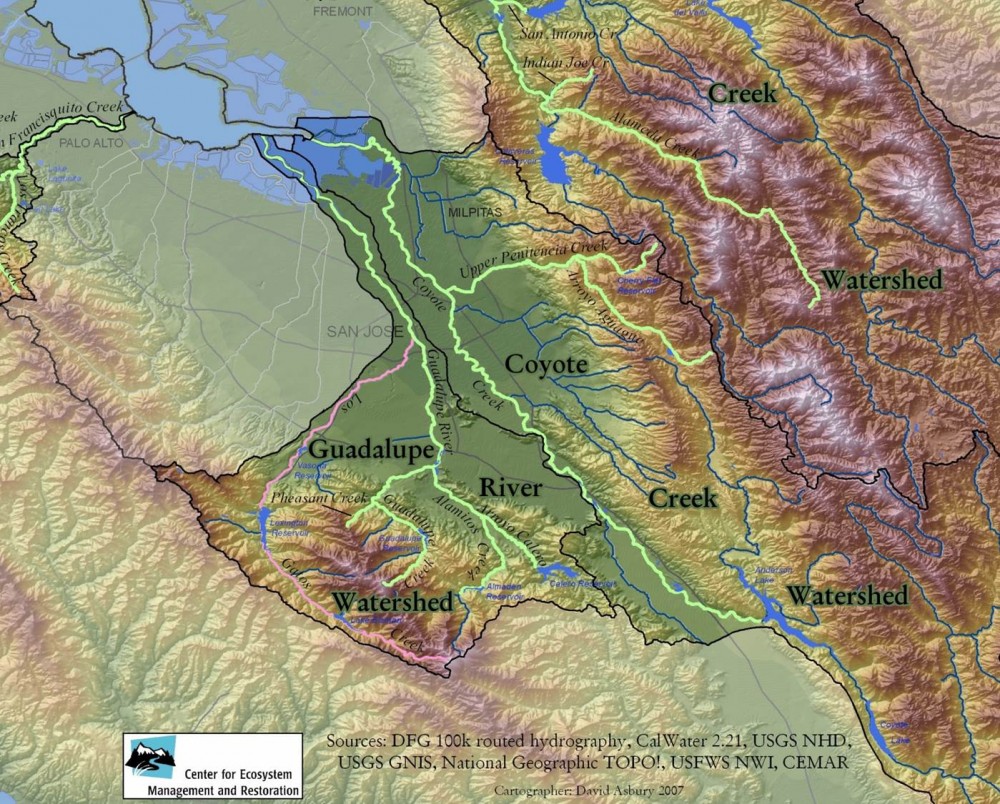Mercury in the Guadalupe Watershed

The Guadalupe River watershed is located just south of the San Francisco South Bay and extends to Loma Prieta, draining 171.3 square miles with a maximum elevation of 3,790 feet. The headwaters of the Guadalupe River watershed begin in the eastern Santa Cruz Mountains and flow 19 miles north, through lakes and reservoirs, to the Guadalupe River and out the Alviso Slough, passing eight salt pond restoration sites before emptying into the South Bay. This historically rich watershed is one of seven anchor watersheds deemed of critical importance to restoring native steelhead (Oncorhynchus mykiss) populations. It is also, home to the New Almaden Mining District.

THIS PROJECT ADVANCES THE FOLLOWING ESTUARY BLUEPRINT GOALS AND ACTIONS
Goals
Water Quality and Quantity
Actions
Action 27
Mercury persists in the environment and in the bodies of people and wildlife that come into contact with it. It is a potent neurotoxin and readily crosses the blood brain barrier causing a number of physical ailments. In the environment, mercury has various forms that are absorbed at different rates, methylmercury being the most bioavailable. Elemental mercury bound in sediments and ores are relatively innocuous until they find their way into low oxygen environments and are methylated. Such environments include wetlands, reservoirs, and lakes. Methylmercury “bioaccumulates” in the food web, meaning that large predator fish and fish-eating birds build up significant amounts of mercury in their bodies. Because of the amount of mercury still present in the Guadalupe River watershed, anglers and subsistence fishers are warned not to eat any fish caught in waters downstream of the mining district including Almaden, Guadalupe and Calero reservoirs, Lake Almaden, the Guadalupe River, and several creeks in the watershed. Mercury has been shown to reduce reproductive success of higher level predators. In addition, sport fish have become one of the largest vectors of mercury absorption in humans. In the South Bay, mercury is very prevalent due to the extensive mining operations in the New Almaden Mining District, located in Santa Clara County’s Guadalupe River watershed. Named after its Spanish predecessor, the mining district was the largest in the United States (5th largest in the world), producing almost 40% of the nation’s total.
The New Almaden Mining District, now largely located within Almaden Quicksilver County Park, operated from 1846 until 1975, when Santa Clara County bought the land. It was the largest mercury mine in North America and produced 5% of the world’s total mercury. The Guadalupe River watershed houses this old mining district and has been significantly impaired by its operations, resulting in a Mercury Total Maximum Daily Load (TMDL) that was finalized in 2008. A TMDL is a regulatory mechanism that puts limits on a given pollutant for a water body that has been listed as impaired by that pollutant. The Guadalupe River TMDL addresses several lakes and reservoirs. These listed water bodies have some of the highest fish methylmercury levels in California, and are posted with “do not eat the fish” signs, one of only two areas in California with “do not eat” fish consumption advisories as contrasted to “limited consumption” advisories.

Mercury in the mining district is bound in a mineral called cinnabar. This reddish-pink rock is naturally occurring and relatively harmless when left alone. When this district was active, miners would excavate the cinnabar ore, roast it to vaporize the mercury, and then dispose of the leftover material. The leftover heat-processed wastes are referred to as calcines.

The method of extraction described above, while effective in extracting mercury, was not perfect. The leftover calcine material still housed hazardous concentrations of mercury. These toxic calcines were commonly disposed of in headwaters high in the mountains where heavy winter storms would flush the material downstream. In other cases they were simply left in large unprotected piles. In this mining district, these calcines were also used to pave portions of the access roads, now trails throughout the park.  These toxic materials have eroded into the watershed over time and have found their way into lakes, reservoirs, and other aquatic environments that can contain low oxygen levels. This is where the relatively harmless sediment-associated mercury is turned into a much more potent form. It is in these low oxygen environments where mercury is methylated by bacteria to form methylmercury. This very bioavailable form of mercury is readily dispersed throughout the water column and is absorbed by photosynthetic algae. Mercury concentrations in the algae are up to 100,000 times higher than that of the surrounding water. The animals that eat the algae are absorbing all of that methylmercury into their bodies and have even greater levels of methylmercury. Each step in the food chain increases the concentration of methylmercury by 2.5x, leaving the top predators like sport fish with hazardous levels in their tissues.
These toxic materials have eroded into the watershed over time and have found their way into lakes, reservoirs, and other aquatic environments that can contain low oxygen levels. This is where the relatively harmless sediment-associated mercury is turned into a much more potent form. It is in these low oxygen environments where mercury is methylated by bacteria to form methylmercury. This very bioavailable form of mercury is readily dispersed throughout the water column and is absorbed by photosynthetic algae. Mercury concentrations in the algae are up to 100,000 times higher than that of the surrounding water. The animals that eat the algae are absorbing all of that methylmercury into their bodies and have even greater levels of methylmercury. Each step in the food chain increases the concentration of methylmercury by 2.5x, leaving the top predators like sport fish with hazardous levels in their tissues.
The first step in solving this mercury problem is to essentially turn off the tap, meaning we halt erosion of the mercury-laden sediments into aquatic environments. There are several ways to do this including soil stabilization, calcine removal and disposal, and capping. By doing this, we can keep the mercury from getting into environments where it can be methylated and enter the food web. Once all sources are controlled, measures to reduce methylation in reservoirs will need to be taken. The Santa Clara Valley Water district is currently testing the effectiveness of oxygen pumps in reservoirs.
The San Francisco Estuary Partnership has worked with many partners to help address the mercury problem in the Guadalupe River watershed and to implement its TMDL. These projects have been funded by several sources including the San Francisco Bay Water Quality Improvement Fund (EPA), and CWA 319(H) (State Water Resources Control Board), Mid-Peninsula Regional Open Space District and Santa Clara County. Our projects include:
Hicks Flat – Complete Project Report
Senador Mine – Complete Project Report
Calcine Paved Roads – Complete Project Report, County Final Report, Avg Calcine Calculations, Site Visit Photos, 100% Construction Designs, County Presentation
Jacques Gulch – This project site was studied and feasibility report was created that detailed the options that could be pursued to remediate the reach. The report found that the cost, stability of the slopes, and large-scale landslides make the remediation of the site infeasible. See feasibility report and site study documents below: Feasibility Report Field Survey Documents